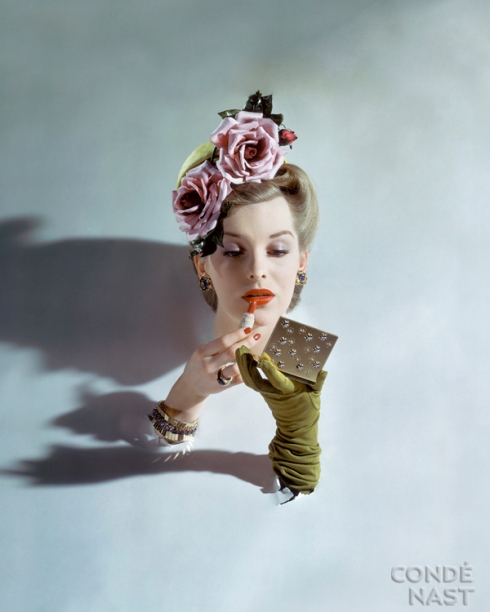John Rawlings (1912-1970) was a Condé Nast Publications fashion photographer from the 1930s through the 1960s. Though Rawlings left a significant body of work, including 200 Vogue magazine and Glamour magazine covers to his credit, he never achieved the name and fame of his lengendary colleagues and masters Cecil Beaten and Horst P. Horst.
 The introduction of American photographer John Rawlings to Vogue’s visual team in 1936 was certainly one of Conde Nast’s best strategic moves. At a time when opulence, pretentiousness, and theatrical lighting were prevalent in fashion photography – fueled by the European school led by the British Beaton, the German Horst, and the Russian Hoyningen-Huene – Nast and Vogue’s editor in chief Edna Woolman Chase decided they needed a change of direction and placed their bets on a talented but unknown twenty-four-year Midwesterner.
The introduction of American photographer John Rawlings to Vogue’s visual team in 1936 was certainly one of Conde Nast’s best strategic moves. At a time when opulence, pretentiousness, and theatrical lighting were prevalent in fashion photography – fueled by the European school led by the British Beaton, the German Horst, and the Russian Hoyningen-Huene – Nast and Vogue’s editor in chief Edna Woolman Chase decided they needed a change of direction and placed their bets on a talented but unknown twenty-four-year Midwesterner.
In two memos sent by Chase, one to her staff in 1937 and another to the photographers in 1938, she demanded more information and less art in Vogue pictures: “Several of the photographs for September fifteenth are nothing but black smudges,” she wrote in the second. “Concentrate completely on showing the dress, light it for this purpose and if that can’t be done with art then art be damned. Show the dress. This is an order straight from the boss’s mouth and will you please have it typed and hung in the studio”.
The change of direction would take a few years, but the man to lead it, John Rawlings, would become one of the most prolific and important photographers of the twentieth century, with more than two hundred Vogue and Glamour covers to his credit. 
His beginnings were unremarkable. Born in Ohio in 1912, John Rawlings attended the local Wesleyan University, and upon graduation in the early 1930s he relocated to New York, where he became a freelance store window dresser. After buying a Leica to photograph his work and show it to potential clients, Rawlings discovered that he enjoyed taking pictures and eventually started to photograph some of the aristocratic clients themselves, alone or with their dogs. A few of those shots found their way to the desk of Nast, who decided to offer Rawlings a job at the Vogue studios as prop builder, studio hand, and apprentice to the legendary masters Beaton and Horst. The young man was so dedicated and worked with such unbridled enthusiasm that four months later he not only was promoted to first assistant to the masters but also got his first photo published in the September 15 issue of Vogue. Impressed by his precocious talent and visual style, Nast and Chase rewarded him in 1937 with a job at the British Vogue studio in London, where he would train and work until the early 1940s. During his time there, Rawlings experimented with his style and began to develop his signature uses of light, setting and posing. His British Vogue work was so impressive it began cirulating in French and American Vogue as well.
Charles Dare Scheips Jr., former director of the Conde Nast Archives, called Rawlings “The first major Conde Nast photographer to demonstrate a truly American eye.”
Rawlings is credited as the first fashion photographer to associate fashion with Hollywood celebrities and also said to have single-handedly elevated commercial photography to an art form.
.
Book
 John Rawlings: 30 Years in Vogue
John Rawlings: 30 Years in Vogue
With over 200 Vogue and Glamour covers to his credit and 30,000 photos in archive, John Rawlings (1912-1970) immortalized the era in which American fashion and style truly came into their own. During his three-decade affiliation with Conde Nast, Rawlings’s work paralleled his publishers’ and editors’ efforts to reformat and expand the power and scope of the fashion press. Rawlings was in the elite circle of Irving Penn, Horst P. Horst, George Hoyningen-Huene, and George Platt Lynes, all top Vogue photographers, yet never received the kind of attention lauded on his colleagues — until now. Drawing on the photographer’s rediscovered archive, curator Kohle Yohannan presents glamour portraits as well as never-before-published nudes that testify to the artist’s ground-breaking and compelling body of work. Photographs of stage, screen, and society stars of the 1940s and 1950s, including Marlene Dietrich, Salvador Dali, Veronica Lake, Lena Horne, and Montgomery Clift are featured.
Veronica Lake
Vivien Leigh
Photographer Irving Penn in his American Field Service uniform.
Actor Peter Ustinov . . .

. . info:
http://bygonefashion.livejournal.com/195868.html
http://www.fashionmefabulous.com/2011/03/famous-fashion-photographers-john.htmlshion Me Fabulous
















Fantastic photographer and info